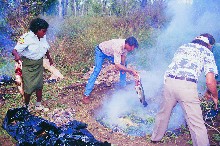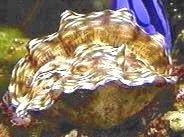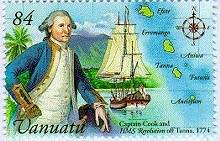| |
Ocean Culture - People and the Sea
|
Exploitation of marine resources
Peoples of Oceania rely greatly on their relationship with the ocean. Knowledge and skills in exploiting marine resources often mean the difference between life and death. The ocean is not only a source of food but also a source of raw materials for making implements, weapons and ornaments.
What is considered to be edible differed between societies. Factors such as palatability, sex, age, social and religious permissibility, influence what was eaten. Marine food items include dugong, seals, sharks, stingrays, turtles (and eggs), scale fish, crabs, marine crayfish, crocodiles, sea snakes, shell fish, mussels, oysters, scallop, sea snails etc.
Exploitation of edible marine resources led to developments in the fishing technologies, swimming and diving skills, weapons and tools associated with the collection/preparation of food, cooking skills, and social structure. In most Oceanic societies, the deeper waters are generally thought of as the male domain where men hunt and fish. Women, in particular, are associated with the intertidal zone from which they collect shellfish while men spear fish in the shallows. |
| |
|
Apart from food, the ocean provides many raw materials useful in every day life. These include: (i) shells and/or corals for tools (shovels, scrapers, shredders, rasps), ornaments, lime, buildings, utensils and money; (ii) shark teeth for weapons (clubs, swords) and ornaments; (iii) shark skin for drum heads; (iv) and various animal bones for tools and weapons.
Conservation of marine resources
|
Throughout the Pacific and around Australia there are systems of home reef and near shore customary marine tenure (CMT) which helps regulate the harvest of marine resources. Tenure refers to an actual process of interacting activities where by people's rights and claims are exercised and negotiated. CMT is enforced on the local level through community institutions, social practices and rules passed down by word of mouth.
Many systems of CMT use management systems involving closed season/areas, prohibition, size limit, equipment control, limit to the number of users and quotas. These systems are now being harnessed to help conserve marine resources by fisheries departments throughout the Pacific. |
 |
Fishing technologies
Skill in fishing is admired in many Pacific Societies and in certain islands fishing is a major focus of social and religious activities.
Many types of early implements and techniques are still used when fishing today. These include netting (meshwork, drag and sweep), trapping (basket traps, weirs, pond), spearing, poisoning (sea slug poison and the pounded roots of particular plants stunned/killed fish), hook and line fishing, and trolling. Methods employed are influenced by knowledge and local conditions.
Equipment includes watercraft; nets; hooks, line and sinkers; spears and clubs; baskets and pots for holding line bait; floating containers for line fish; and containers for hook and lines. Lookout towers are still sometimes used to spot turtles, dugongs and fish.
|
Today, Pacific village-level fishers provide about 60% of the protein supply. Highly regarded marine species include green mangrove crab (Scylla paramamosain), sea grapes (Caulerpa racemosa), octopus (Octopus sp.), black teatfish (Microthele fuscogilva), trochus shell (Trochus niloticus), smooth giant clam (Tridacna desara), painted rock lobster (Panulirus versicolor), green turtle (Chelonia mydas), spangled emperor (Lethrinus nebulosus), big-spot coral trout (Plectroponus sp.) and wahoo (Acanthocybium solandri).
In Vanuatu, total seafood consumption is about 76.5 kg per capita per year. This figure is thought to be representative for village-level fishers in other Pacific Island nations. |

Tridacna sp |
Europeans arrive in the Pacific
 |
Cook's historic voyages to the Pacific (1768–1771; 1771–1775; 1776–1779) brought the existence of the peoples of Oceania to the attention of the Western World and marked the coming of new cultures to the Pacific.
As a result of the subsequent contact with Europeans, many Oceanic peoples have been involved at various times in producing for the global economy including such commodities as whale oil, seal skins, sandalwood, pearls, cotton, coconut oil, guano became important exports. Increased foreign trade led to the rise of port towns. |
Next .. Australian Ocean Culture in the new millennium
|
|
|
|
|
|
Photographs in this section are courtesy of Wet Paper, Queensland Fisheries and Neville Coleman |
|